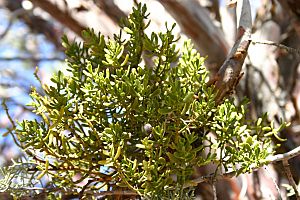Phoradendron densum facts for kids
Quick facts for kids Phoradendron densum |
|
|---|---|
 |
|
| Scientific classification | |
| Genus: |
Phoradendron
|
| Species: |
densum
|
Phoradendron densum, also known as dense mistletoe, is a special kind of flowering plant. It belongs to the sandalwood family. Unlike most plants, dense mistletoe is a parasite. This means it grows on other plants and gets its food and water from them. It doesn't hurt its host tree too much, but it does rely on it to live.
Contents
What is Dense Mistletoe?
Dense mistletoe is a plant that grows on trees like cypress and juniper. It attaches itself to the branches of these "host" trees. It then takes water and nutrients from the host tree to help itself grow. Think of it like a houseguest that eats your food!
Where Dense Mistletoe Lives
This plant is found in the western United States and northwestern Mexico. It likes to grow in different types of forests and woodlands. You can find it in states like California, Oregon, and Arizona. It also grows in Baja California in Mexico.
How Dense Mistletoe Looks
Dense mistletoe often looks like a tangled bush hanging in the branches of its host tree. Its own branches can grow to be about 30 to 50 centimeters long. That's about the length of a school ruler! The plant has small green leaves, usually about one centimeter long and half a centimeter wide.
Life Cycle and Reproduction
Dense mistletoe plants are either male or female. This is called being dioecious.
- Male plants produce small, round, knob-like flowers. These flowers make pollen.
- Female plants also have small, round flowers. After these flowers are pollinated, they grow into small, round berries.
The berries are about 4 millimeters wide, which is tiny! When they are ripe, they can be yellowish or a pale pink color. These berries contain the seeds that will grow into new mistletoe plants. Birds often eat the berries and help spread the seeds to new trees.

